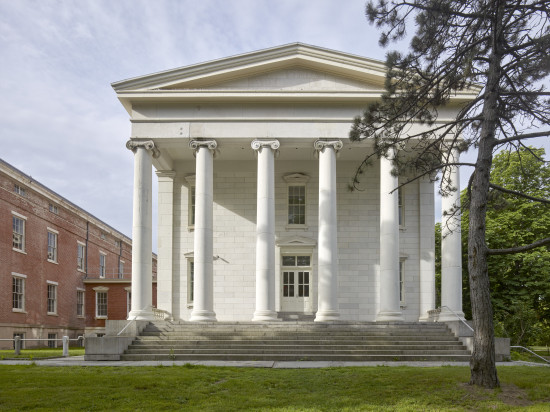
Ten years in the making, the renovation of one of Staten Island‘s oldest buildings—part of the Staten Island Museum expansion—is finally complete. Well, almost.
Stepping into the refurbished Cultural Center building just off of Staten Island’s seafront, the smell of fresh paint still hangs lightly in the air as designers and the team behind the project apply the final touches to Gluckman Tang Architects‘ (formerly Gluckman Mayner) design.
Originally used by sailors, the 1879 landmarked ‘Building A’ at Snug Harbor follows the Greek Revival style of the adjacent structures. So far, it has taken ten years from proposal to opening, and four years to construct, at a cost of $24.4 million.
Speaking to AN, James Young-Suk Lim, of New York–based Gluckman Tang, told of the difficulties they had in creating “acceptable climate conditions” for the galleries. “The project was unique as we had to keep so much due to the building’s status as a national landmark,” he said. The building was actually one of the first to be given landmark status by New York’s Landmarks Preservation Commission (LPC).
Despite gutting the 18,000-square-foot building, opening it up for gallery use, Gluckman Tang appropriately employed a subtle design approach to the interior. During this process, load-bearing walls were replaced by structural columns, creating an open feel and giving visitors more space to explore. Much of the inside is white meanwhile fire-proof doors use frame fitting glass panes. The technique visually invites people into the galleries and continues to open up circulation spaces that would otherwise be empty voids.
This minimalist approach also gave the museum and exhibition designers greater freedom and flexibility to adapt the space. In this instance, the exhibition design by Ralph Appelbaum Associates (also from New York) employs a similar minimalist glass strategy and complements the work by Gluckman Tang. Walls have been painted pastel green, creating an air of calmness and tranquility, with the subtle color change acting as a visual threshold between the gallery and circulation spaces.
Keeping the temperature at 70 degrees and at 50 percent relative humidity (a museum requirement) was always going to be a tough task given the mandate to maintain certain historical elements of the building, notably the 19th century windows and window frames. Consequently, a new building envelope was created inside the existing structure.
The architects installed floor-to-ceiling windows with Low E soft coatings that were recessed from the original bays. The windows act as a “vapor barrier,” yet allow users to still view old windows. Translucent pull down blinds shade the art from damaging sunlight, while soft interior lighting modules placed along rails in the ceiling enhance the display. This feature allows the circulatory spaces that are not bound by daylight regulations to become brighter, amplifying the threshold existing between the spaces.
In addition to this, the building is also a LEED Gold project. Some 18 geothermal energy piles were drilled 499 feet (500 feet requires mining permission) to provide energy to the building, of which the majority will be used for climate control.
The latest addition to the Staten Island Museum will feature a diverse range of cultural and historical artifacts ranging from fish fossils to art from the island. The inaugural exhibitions will be open to the public on Saturday, September 19 at 10:00a.m.